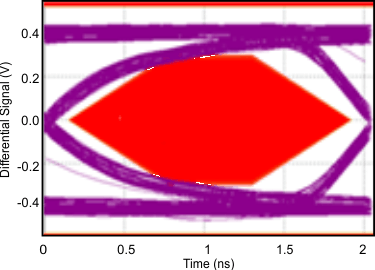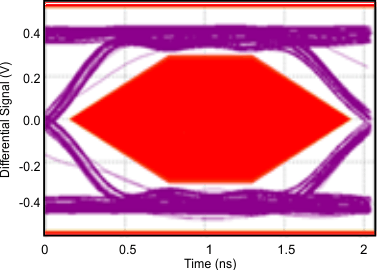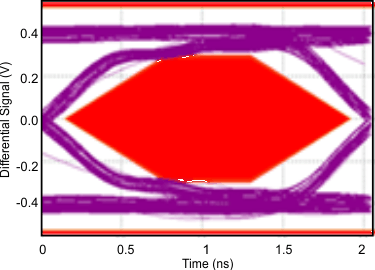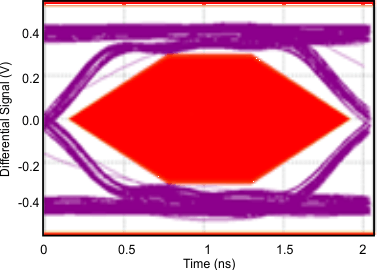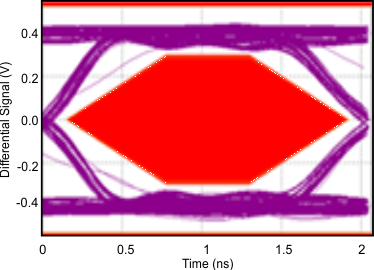TUSB211 USB 2.0 高速信号调节器
1 特性
3 说明
TUSB211 是一款 USB 高速 (HS) 信号调节器,专为补偿传输通道中的 ISI 信号损失而设计。
该器件采用了对 USB 低速 (LS) 和全速 (FS) 信号无感知的设计,该设计正在申请专利。LS 和 FS 信号特征不受 TUSB211 的影响。该器件只能对 HS 信号进行补偿。
该器件具有可编程的信号增益,可精调器件性能,从而对连接器上的高速信号进行优化。这对于通过 USB 高速电气兼容性测试很有帮助。
TUSB211 的封装不会损坏 DP/DM 信号路径的连续性。这样一来,便可以针对完整 USB 通道实现零风险系统设计。
此外,TUSB211 符合 USB On-The-Go (OTG) 和电池充电 (BC) 协议。
器件信息 (1)
| 部件号 | 封装 | 封装尺寸(标称值) |
|---|---|---|
| TUSB211 | X2QFN (12) | 1.60mm x 1.60mm |
| TUSB211I |
- 如需了解所有可用封装,请参阅产品说明书末尾的可订购产品附录。
4 修订历史记录
Changes from C Revision (June 2016) to D Revision
Changes from A Revision (June 2015) to B Revision
Changes from * Revision (May 2015) to A Revision
- 将产品说明书从“产品预览”更改成了“生产”Go
5 Pin Configuration and Functions
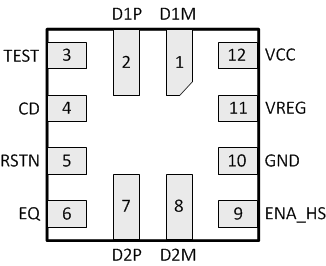
Pin Functions
| PIN | I/O | INTERNAL PULLUP/PULLDOWN |
DESCRIPTION | |
|---|---|---|---|---|
| NAME | NO. | |||
| VCC | 12 | P | N/A | 3.3-V power |
| VREG | 11 | O | RSTN asserted: 30 kΩ PD | 1.8-V LDO output. Only enabled when operating in High Speed mode. Requires 0.1-µF external capacitor to GND to stabilize the core. |
| FS, LS mode: 30 kΩ PD | ||||
| HS mode: N/A | ||||
| GND | 10 | P | N/A | Ground |
| RSTN | 5 | I | 500 kΩ PU | Device disable/enable. Recommend 0.1-µF external capacitor to GND to ensure clean power on reset if not driven. |
| EQ | 6 | I | N/A | USB High Speed boost select via external pull down resistor. Sampled upon power up. Auto selects min EQ when left floating. Does not recognize real time adjustments. |
| D1P | 2 | I/O | N/A | USB High Speed positive port. Orientation independent – Can face either upstream or downstream. |
| D1M | 1 | I/O | N/A | USB High Speed negative port. Orientation independent – Can face either upstream or downstream. |
| D2P | 7 | I/O | N/A | USB High Speed positive port. Orientation independent – Can face either upstream or downstream. |
| D2M | 8 | I/O | N/A | USB High Speed negative port. Orientation independent – Can face either upstream or downstream. |
| TEST | 3 | I | RSTN asserted: 500 kΩ PD | No function. Leave floating. |
| ENA_HS | 9 | O | RSTN asserted: 500kΩ PD | Flag indicating that channel is in High Speed mode. Asserted upon:
De-asserted upon detection of disconnect or suspend. Can be left floating if not needed. |
| CD | 4 | O | RSTN asserted: 500 kΩ PD | Flag indicating that a USB device is attached. Asserted from an unconnected state upon detection of DP or DM pull-up resistor. De-asserted upon detection of disconnect. Can be left floating if not needed. |
6 Specifications
6.1 Absolute Maximum Ratings
over operating free-air temperature range (unless otherwise noted) (1)| MIN | MAX | UNIT | ||
|---|---|---|---|---|
| Supply voltage range | VCC | –0.3 | 3.8 | V |
| Voltage range | D1P, D1M, D2P, D2M, RSTN, EQ | –0.3 | 3.8 | V |
| Storage temperature, Tstg | –65 | 150 | °C | |
6.2 ESD Ratings
| VALUE | UNIT | |||
|---|---|---|---|---|
| V(ESD) | Electrostatic discharge | Human-body model (HBM), per ANSI/ESDA/JEDEC JS-001 (1) | ±3000 | V |
| Charged-device model (CDM), per JEDEC specification JESD22-C101 (2) | ±1000 | |||
6.3 Recommended Operating Conditions
over operating free-air temperature range (unless otherwise noted)| MIN | NOM | MAX | UNIT | ||
|---|---|---|---|---|---|
| VCC | Supply voltage | 3 | 3.3 | 3.6 | V |
| TA | Operating free-air temperature [TUSB211] | 0 | 70 | °C | |
| Operating free-air temperature [TUSB211I] | –40 | 85 | |||
6.4 Thermal Information
| THERMAL METRIC (1) | RWB | UNIT | |
|---|---|---|---|
| 12 PINS | |||
| RθJA | Junction-to-ambient thermal resistance | 161.6 | °C/W |
| RθJC(top) | Junction-to-case (top) thermal resistance | 63.3 | °C/W |
| RθJB | Junction-to-board thermal resistance | 75.1 | °C/W |
| ψJT | Junction-to-top characterization parameter | 1.9 | °C/W |
| ψJB | Junction-to-board characterization parameter | 75.1 | °C/W |
| RθJC(bot) | Junction-to-case (bottom) thermal resistance | N/A | °C/W |
6.5 Electrical Characteristics
over operating free-air temperature range (unless otherwise noted)| PARAMETER | TEST CONDITIONS | MIN | TYP (1) | MAX | UNIT | |
|---|---|---|---|---|---|---|
| I(ACTIVE_HS) | High Speed Active Current | USB channel = HS mode. 480 Mbps traffic. VCC supply stable | 16 | 20 | mA | |
| I(IDLE_HS) | High Speed Idle Current | USB channel = HS mode. No traffic. VCC supply stable | 12 | 15 | mA | |
| I(SUSPEND_HS) | Suspend Current | USB channel = Suspend mode. | 4.5 | 5.5 | mA | |
| I(FS) | Full-Speed Current | USB channel = FS mode | 4.5 | 5.5 | mA | |
| I(LS) | Low-Speed Current | USB channel = LS mode | 4.5 | 5.5 | mA | |
| I(DISCONN) | Disconnect Power | Host side application. No device attachment. | 4.5 | 5.5 | mA | |
| I(RSTN) | Disable Power | RSTN driven low; VCC supply stable; VCC = 3.3 V | 4.5 | 5.5 | mA | |
| RSTN | ||||||
| VIH | High level input voltage | 2 | VCC | V | ||
| VIL | Low-level input voltage | 0 | 0.8 | V | ||
| IIH | High level input current | VIH = 3.6 V, VCC = 3 V, RPU enabled | ±2 | µA | ||
| IIL | Low level input current | VIL = 0V, VCC = 3.6 V, RPU enabled | ±11 | µA | ||
| EQ | ||||||
| R(EQ) | External pulldown resistor | Level 0 EQ | 0.32 | kΩ | ||
| Level 1 EQ | 1.4 | 2.2 | kΩ | |||
| Level 2 EQ [MAX] | 3.7 | 4.1 | kΩ | |||
| Level 3 EQ [MIN] | 6 | kΩ | ||||
| CD, ENA_HS | ||||||
| VOH | High level output voltage | IO = –50 µA | 2.4 | V | ||
| VOL | Low level output voltage | IO = 50 µA | 0.4 | V | ||
| DxP, DxM | ||||||
| T(SHRT_GND) | DP, DM low voltage short circuit | DxP or DxM short circuited to GND continuously for 24 hours at TA = 25°C only |
0 | V | ||
| CIO(DXX) | Capacitance to GND | Measured with LCR meter and device powered down. 1 MHz sinusoid, 30 mVpp ripple | 5 | pF | ||
6.6 Switching Characteristics
over operating free-air temperature range (unless otherwise noted)| PARAMETER | TEST CONDITIONS | MIN | TYP (1) | MAX | UNIT | |
|---|---|---|---|---|---|---|
| DxP, DxM | ||||||
| F(BR_DXX) | Bit Rate | USB channel = HS mode. 480 Mbps traffic. VCC supply stable | 480 | Mbps | ||
| t(R/F_DXX) | Rise/Fall time | 100 | ps | |||
| CD, ENA_HS | ||||||
| t(EN) | Enable time | 20 | µs | |||
| t(DIS) | Disable time | 20 | µs | |||
| VCC | ||||||
| t(STABLE) | VCC stable before RSTN de-assertion | 100 | µs | |||
| t(RAMP) | VCC ramp time | 0.2 | 100 | ms | ||
7 Detailed Description
7.1 Overview
The TUSB211 is a USB High-Speed (HS) signal conditioner, designed to compensate for ISI signal loss in a transmission channel. TUSB211 has a patent-pending design which is agnostic to USB Low Speed (LS) and Full Speed (FS) signals and does not alter their signal characteristics, while HS signals are compensated. In addition, the design is compatible with USB On-The-Go (OTG) and Battery Charging (BC) specifications.
Programmable signal gain through an external resistor permits fine tuning device performance to optimize signals helping to pass USB HS electrical compliance tests at the connector.
The footprint of TUSB211 allows a board layout using this device such that it does not break the continuity of the DP/DM signal traces. This permits risk free system design of a complete USB channel with flexible use of one or multiple TUSB211 devices as needed for optimal signal integrity. This allows system designers to plan for this device and use it only if signal integrity analysis and/or lab measurements show a need. If such a need is not warranted, the device can be left unpopulated without any board rework.
7.2 Functional Block Diagram

7.3 Device Functional Modes
7.3.1 Low Speed (LS) Mode
TUSB211 automatically detects a LS connection and does not enable signal compensation. CD pin is asserted high.
7.3.2 Full Speed (FS) Mode
TUSB211 automatically detects a FS connection and does not enable signal compensation. CD pin is asserted high.
7.3.3 High Speed (HS) Mode
TUSB211 automatically detects a HS connection and enables signal compensation as determined by the configuration of the external pulldown resistance on its EQ pin. ENA_HS pin asserted high in addition to the CD pin.
7.3.4 Disable Mode
TUSB211 can be disabled when its RSTN pin is asserted low. The USB channel is still fully operational, but there is neither signal compensation, nor any indication from the CD pin or ENA_HS pin as to the status of the channel.
8 Application and Implementation
NOTE
Information in the following applications sections is not part of the TI component specification, and TI does not warrant its accuracy or completeness. TI’s customers are responsible for determining suitability of components for their purposes. Customers should validate and test their design implementation to confirm system functionality.
8.1 Application Information
The primary purpose of the TUSB211 is to re-store the signal integrity of a USB High Speed channel up to the USB connector. The loss in signal quality stems from reduced channel bandwidth due to high loss PCB trace and other components that contribute a capacitive load. This can cause the channel to fail the USB near end eye mask. Proper use of the TUSB211 can help to pass this eye mask.
A secondary purpose is to use the CD pin and ENA_HS pin of the TUSB211 to control other blocks on the customer platform if so desired.
8.2 Typical Application
A typical application is shown below. In this setup, D1P and D1M face the USB connector while D2P and D2M face the USB transceiver. If desired, the orientation may be reversed [that is, D1 faces transceiver and D2 faces connector].
Note that CD and ENA_HS are connected to PLDs. This is for platforms where other circuit blocks must be modified based on the status of the USB channel. They could also be connected to LEDs to give a physical indication of current channel status for debug purposes. If neither use is desired, they can be left floating.
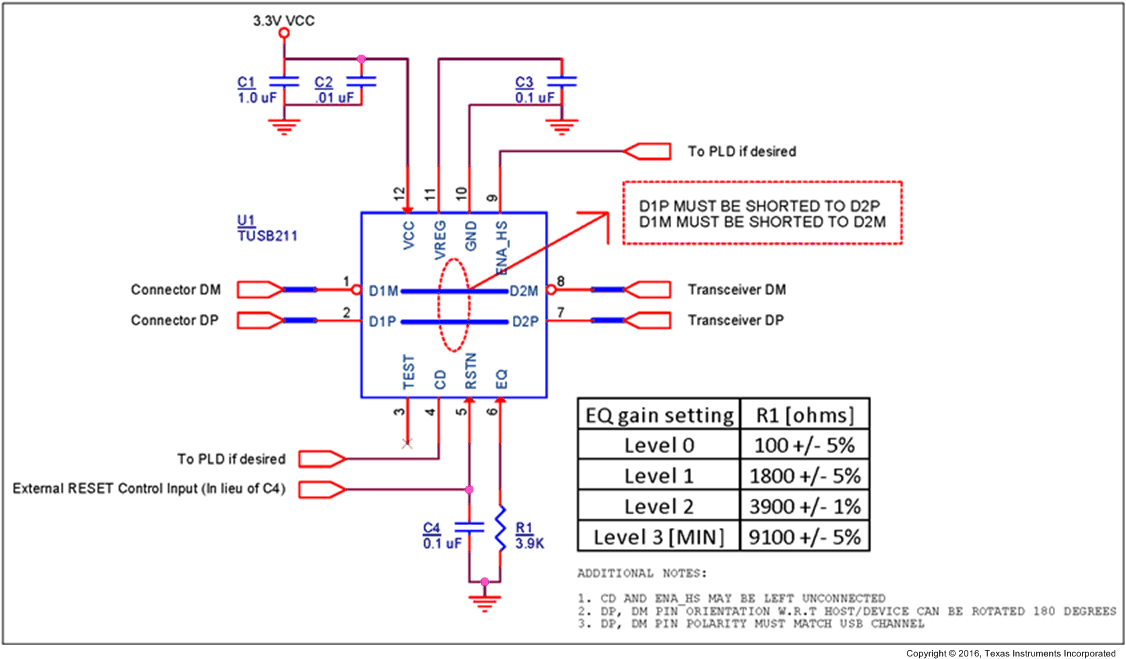 Figure 1. Reference Schematic
Figure 1. Reference Schematic
8.2.1 Design Requirements
TUSB211 requires a valid reset signal as described in the power supply recommendations section. The capacitor C4 is not required if a microcontroller drives the RSTN pin according to recommendations.
Pin 11 VREG is an internal LDO output that requires a 0.1 μF external capacitor to GND to stabilize the core.
Pin 6 EQ requires an external pulldown resistor if EQ levels 0-2 are needed. If EQ level 3 is needed, then the EQ pin can be left floating.
8.2.2 Detailed Design Procedure
The ideal EQ setting is dependent upon the signal chain loss characteristics of the target platform. The general recommendation is to start with EQ level 0, and then increment to EQ level 1, and so on. if permissible.
In order for the TUSB211 to recognize any change to the EQ setting, the RSTN pin must be toggled. This is because the EQ pin is latched on power up and the pin is ignored thereafter.
In addition, TUSB211 does not compensate for any DC attenuation in the signal path. Therefore, minimizing DC loss (that is, resistance) in the system design, is suggested. As a consequence, this might lead to increased line capacitance. This is acceptable because the TUSB211 can compensate for the additional capacitive load.
Placement of the device is also dependent on the application goal. Table 1 summarizes the recommendations.
Table 1. TUSB211 Platform Placement Guideline
| PLATFORM GOAL | SUGGESTED TUSB211 PLACEMENT |
|---|---|
| Pass USB Near End Mask | Close to measurement point |
| Pass USB Far End Eye Mask | Close to USB PHY |
| Cascade multiple 211s to improve device enumeration | Midway between each USB interconnect |
NOTE
USB-IF certification tests for High Speed eye masks require the mandated use of the USB-IF developed test fixtures. These test fixtures do not require the use of oscilloscope probes. Instead they use SMA cables. More information can be found at the USB-IF Compliance Updates Page. It is located under the ‘Electricals’ section, ID 86 dated March 2013.
The following procedure must be followed before using any oscilloscope compliance software to construct a USB High Speed Eye Mask:
8.2.2.1 For a Host Side Application
- Configure the TUSB211 to the desired EQ setting
- Power on (or toggle the RSTN pin if already powered on) the TUSB211
- Using SMA cables, connect the oscilloscope and the USB-IF host-side test fixture to the TUSB211
- Enable the host to transmit USB TEST_PACKET
- Execute the oscilloscope’s USB compliance software.
- Repeat the above steps in order to re-test TUSB211 with a different EQ setting
8.2.2.2 For a Device Side Application
- Configure the TUSB211 to the desired EQ setting
- Power on (or toggle the RSTN pin if already powered on) the TUSB211
- Connect a USB host, the USB-IF device-side test fixture, and USB device to the TUSB211. Ensure that the USB-IF device test fixture is configured to the ‘INIT’ position
- Allow the host to enumerate the device
- Enable the device to transmit USB TEST_PACKET
- Using SMA cables, connect the oscilloscope to the USB-IF device-side test fixture and ensure that the device-side test fixture is configured to the ‘TEST’ position.
- Execute the oscilloscope’s USB compliance software.
- Repeat the above steps in order to re-test TUSB211 with a different EQ setting
8.2.3 Application Curves
 Figure 2. Eye Diagram Bench Setup
Figure 2. Eye Diagram Bench Setup
